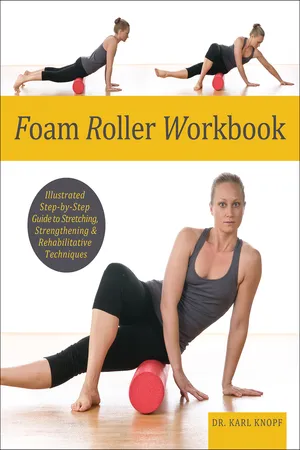
eBook - ePub
Foam Roller Workbook
Illustrated Step-by-Step Guide to Stretching, Strengthening & Rehabilitative Techniques
- 195 pages
- English
- ePUB (mobile friendly)
- Available on iOS & Android
eBook - ePub
Foam Roller Workbook
Illustrated Step-by-Step Guide to Stretching, Strengthening & Rehabilitative Techniques
About this book
Amplify your stretches and exercises and prevent and rehabilitate injuries with these foam roller workouts from the bestselling health and fitness author.
Once used exclusively in physical therapy settings, the foam roller has made its way into yoga and pilates studios, gyms and homes. With this simple device, you can:
Foam Roller Workbook offers fifty effective exercises paired with clear captions and step-by-step photos that will help you roll your way to better posture, balance and relaxation. In addition, special programs will enhance your sporting life, whether you hit the track, the court, or the slopes.
Once used exclusively in physical therapy settings, the foam roller has made its way into yoga and pilates studios, gyms and homes. With this simple device, you can:
- Improve core strength
- Increase flexibility
- Release tension
- Alleviate pain
- Rehabilitate injuries
Foam Roller Workbook offers fifty effective exercises paired with clear captions and step-by-step photos that will help you roll your way to better posture, balance and relaxation. In addition, special programs will enhance your sporting life, whether you hit the track, the court, or the slopes.
Frequently asked questions
Yes, you can cancel anytime from the Subscription tab in your account settings on the Perlego website. Your subscription will stay active until the end of your current billing period. Learn how to cancel your subscription.
At the moment all of our mobile-responsive ePub books are available to download via the app. Most of our PDFs are also available to download and we're working on making the final remaining ones downloadable now. Learn more here.
Perlego offers two plans: Essential and Complete
- Essential is ideal for learners and professionals who enjoy exploring a wide range of subjects. Access the Essential Library with 800,000+ trusted titles and best-sellers across business, personal growth, and the humanities. Includes unlimited reading time and Standard Read Aloud voice.
- Complete: Perfect for advanced learners and researchers needing full, unrestricted access. Unlock 1.4M+ books across hundreds of subjects, including academic and specialized titles. The Complete Plan also includes advanced features like Premium Read Aloud and Research Assistant.
We are an online textbook subscription service, where you can get access to an entire online library for less than the price of a single book per month. With over 1 million books across 1000+ topics, we’ve got you covered! Learn more here.
Look out for the read-aloud symbol on your next book to see if you can listen to it. The read-aloud tool reads text aloud for you, highlighting the text as it is being read. You can pause it, speed it up and slow it down. Learn more here.
Yes! You can use the Perlego app on both iOS or Android devices to read anytime, anywhere — even offline. Perfect for commutes or when you’re on the go.
Please note we cannot support devices running on iOS 13 and Android 7 or earlier. Learn more about using the app.
Please note we cannot support devices running on iOS 13 and Android 7 or earlier. Learn more about using the app.
Yes, you can access Foam Roller Workbook by Karl Knopf in PDF and/or ePUB format, as well as other popular books in Biological Sciences & Alternative & Complementary Medicine. We have over one million books available in our catalogue for you to explore.
Information
part 1
getting started

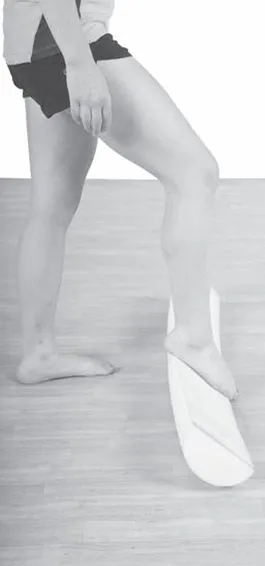
foam roller: the magic bullet?
Foam rollers were once used exclusively in physical therapy settings. In fact, Dr. Moshé Feldenkrais was credited with being the first person to use rollers for therapeutic purposes (e.g., improving body alignment, reducing muscle tightness, teaching body awareness) in the late 1950s.
Now they’re used in yoga and Pilates classes to strengthen the body as well as relax and stretch tight muscles. They’re also available in most gyms’ stretching areas.
Some experts suggest that, if not addressed early, minor muscle imbalances (such as those tight, tender spots) can contribute to serious injuries or chronic dysfunction later on, which may require expensive therapy. Prevention is always easier and cheaper than treatment. Foam rollers are a wonderful way to address the above concerns while adding diversity and challenge to your standard exercise program.
Designing a balanced exercise routine that includes flexibility movements with strength training, cardiovascular exercise and relaxation can reduce chronic discomfort. Since foam rollers break up interwoven muscle fibers and help move oxygenated blood into those muscles, they’re an excellent vehicle with which to release those tight spots in muscles (the technical term is “myofascial release”) and return the muscles to a more optimal state. This can be done prior to exercising to improve range of motion, or after a workout to relax tight muscles and reduce soreness.
The beauty of the roller is that it’s inexpensive and easy to use, and can be utilized to rehabilitate your body as well as prevent possible issues such as lower back pain and shin splints. Foam Roller Workbook provides you with numerous exercises to improve posture, core stability and flexibility, as well as hone dynamic balance and mindful relaxation.
dp n="10" folio="9" ? 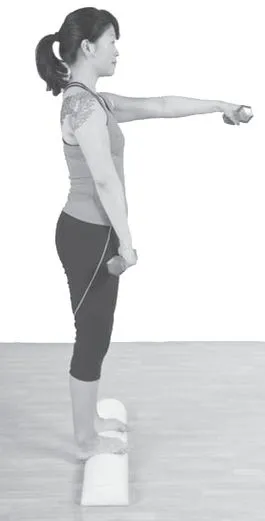
why use foam rollers?
The human body is designed in a remarkable manner and, if well maintained, will function efficiently for a very long time. Unfortunately, all too often we misuse or abuse our bodies, perhaps through activities of daily living or overuse. Whether you’re highly active or sedentary, we all can benefit from a few minutes of light stretching and relaxation every day. A gentle, daily dose of movement keeps the joints lubricated and limber—motion is lotion.
More and more research in the field of exercise science shows that many of our chronic health issues can be positively influenced with corrective exercise. A former chief of orthopedics at Stanford University’s School of Medicine once told me, “Modern medicine can do remarkable things, but we are nowhere close to rebuilding the human machine as well as the original equipment we were born with.”
Today, therapists use progressive stretching programs and teach proper body mechanics as part of their standard arsenal to help ease clients’ dysfunctions. Proper therapeutic exercise done regularly and performed prudently under the supervision of a trained therapist or personal trainer can be used to prevent injury, alleviate pain and restore your body to optimal levels.
You might already incorporate dumbbells, balance balls and resistance bands into your exercise program. Foam rollers are another tool that can provide an exciting and challenging dimension to your workout. One of the many great things about the foam roller is that it can be used by anyone, from severely disabled individuals to elite athletes. A simple adaptation can transform a basic exercise into an extreme challenge, thus allowing you to progressively ramp up the intensity of your routine and keep you from becoming bored.
A foam roller, used properly, is very effective for improving:
• Range of motion
• Core stability
• Balance
• Body awareness
• Flexibility
• Coordination
• Focus
• Body relaxation
The concept is that when you can perform an activity on a solid surface, you should progress to a less-stable platform in order to prompt your body to work harder. When you’re on an unstable surface such as a foam roller, your body recruits more superficial and deep-lying muscles in order to maintain proper balance and body alignment. Some people often perform their normal exercise routine while standing or lying on a roller. By doing this, they not only isolate a particular muscle, they engage the whole kinetic chain, thus challenging all the major and deep-lying muscles.
Essentially, the exercises in this book, in concert with feedback from your health provider or massage therapist, can help you develop a better-balanced body. They’ll keep your muscles toned and supple, which fosters improved functional fitness. They’ll also demand that you practice proper posture and muscle alignment, which prevents joint dysfunctions and chronic pain. Joseph Pilates may have said it better: “Stretch what is tight and strengthen what is lax.”
Lightweight and inexpensive, foam rollers can be stored almost anywhere, like under the bed or in a closet. Another advantage of foam roller exercises is that they can be done in the privacy of your home and you don’t even need to put on exercise clothes. All you need is enough space to lie down and spread your arms.

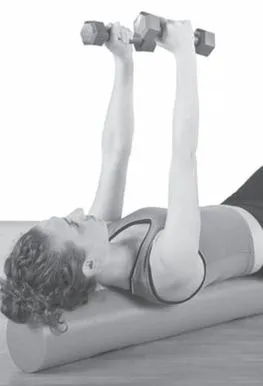
choosing a roller
Rollers come in a variety of shapes, sizes and densities and can be purchased online, at sporting goods stores and at physical therapy clinics. Selecting the type and length of roller you’ll need is a personal decision, dependent on your height and weight, experience level and overall needs.
The most common roller configurations are semicircular or circular, either three feet or one foot long. Semicircular rollers, sometimes referred to as “half rollers,” are flat on one side and curved on the other; they’re typically three inches in diameter. Circular, or round, rollers are generally six inches in diameter.
Circular rollers are more unstable (and thus more challenging) than their semicircular counterparts. Note that you can place half rollers either flat side down or up. Having the flat side down is more stable than placing the round side down. Dense, firm rollers are good for self-massage, but if you’re especially stiff, you may want to start with a softer roller so that your muscles can more easily acclimate to the pressure.
All exercises in this book utilize rollers that are three feet long, but some can be performed on shorter rollers. We refer to full-length half rollers as “FLHR” and full-length circular rollers as “FLCR.”
If you’re a beginner, a half roller is best. If you’re looking to challenge yourself, you’ll want a circular roller. Some people purchase one long roller and cut it to best meet their needs. Gyms often have various rollers you can experiment with.

Left: Half roller, flat side down. Middle: Half roller, flat side up. Right: Circular roller.
dp n="13" folio="12" ? 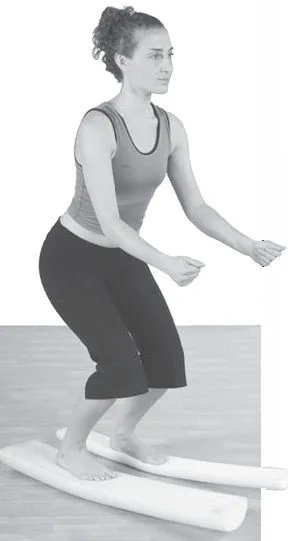
before you begin
Using a roller looks like child’s play, but utilizing it correctly is no easy feat. Before you roll your way to better posture, flexibility and relaxation, you should do all you can to make sure you’re performing the exercises correctly and that your exercises and massages are comfortable and things you look forward to—they shouldn’t cause pain. Always tune in to your body and stop if something feels wrong. Stepping, lying, kneeling or sitting on the roller should be your time to relax, refresh and renew yourself.
Safety
Foam rollers can be used by anyone, but if you’ve been diagnosed with a medical condition, it’s highly recommended that you obtain personalized instruction from a trained therapist prior to engaging in a roller exercise program. It is ill-advised to use the roller if you suffer from the following: severe pain, poor range of motion/flexibility, poor balance, poor coordination, and/ or the inability to get up and down from the floor unassisted. It is always wise to ask your therapist to review this book and select the best exercises for you to start with. It’s critical to train smart, not hard. Many of the conditions we suffer from took a long time to manifest themselves, so be patient in expecting results. Some chronic conditions such as arthritis can’t be cured, but they can be managed very well with proper exercise.
Even if you’re in good health, it’s wise to have someone spot you when first getting start...
Table of contents
- Title Page
- part 1 - getting started
- part 2 - the programs
- part 3 - the exercises
- index
- other ulysses press books
- Acknowledgements
- about the author
- Copyright Page